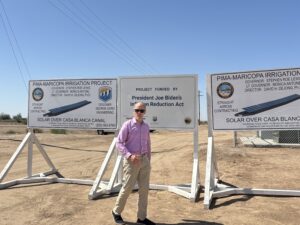- Slug: Gila River Solar Canal. 660 words.
- Photos available (thumbnails, captions below).
By Jalen Woody
Cronkite News
SACATON – In the heart of Sacaton, located south of Phoenix, the Gila River Indian Community received nearly $6 million in funds from the Biden administration in 2023 to create a renewable energy plan involving the construction of solar panels over the Casa Blanca Canal.
Funding came from the Inflation Reduction Act, part of Biden’s Investing In America agenda, which aimed to combat the effects of climate change with new projects to conserve energy, according to the Department of the Interior. The project aims to cover 2,782 feet of the canal and requires approximately 2,556 solar panels.
On Thursday, Gila River Indian Community Gov. Stephen Roe Lewis; along with Rep. Greg Stanton, an Arizona Democrat; Tom Perez, director of the White House Office of Intergovernmental Affairs and senior adviser and assistant to Joe Biden; and David Palumbo, the Bureau of Reclamation deputy commissioner, turned on the first power to the canal project.
As the tribe powers on the innovative project, Vice President Kamala Harris is touting the administration’s record with sustainability projects and using it to appeal to Native American voters on her campaign trail.
According to Lewis, the solar panels help create renewable energy by reducing the rate of evaporation in the canal by almost 50% compared to when the canal was uncovered.
“We’re hoping to validate (this) for future projects that are looking at us as the model,” Lewis said. “The water cools underneath (the solar panels) and makes the solar panels even more power generating as well.”
In an orange-tinted haze on a hot October afternoon, the solar panels perched a couple feet above the water in the canal as it flowed. The water rippled and gurgled as speakers from around the country gathered in front of a large power box to celebrate its contribution to the residents of Sacaton.
Lewis, Stanton, Perez and Palumbo each took the stage one by one to discuss the project’s importance to the community and its possibility as a blueprint for other similar projects in the future.
“The Gila River Indian Community has done more on the issue of water conservation than any other entity in the state of Arizona. We simply can’t overcome the issues of drought here in Arizona without the leadership of tribal communities and the Gila River Indian Community, ” Stanton said. “You put it all together (and) it’s a really magical project that’s going to capture the imaginations of so many people.”
Perez said the importance of this project in Arizona was attributed to the people of the Gila River Indian Community and how they planned, strived and dreamed of this project for many years. This project marks history in the United States as the first solar panel-over-canal project sanctioned in the Western Hemisphere.
According to the Department of the Interior, the project will generate 1.31 megawatts of clean energy for the tribal nation.
The Biden administration has “100% confidence that $1 spent, $1 invested here, is $1 well spent because of all of you. And so, I want to say that, on behalf of the president and the vice president, folks, as we sit here today, we need to acknowledge something that is obvious to you and should be obvious to everyone around the country, we’re in the middle of a climate crisis,” Perez said.
The Central Arizona Project, which is in charge of the canals in Arizona that span 336 miles from Lake Havasu City to Tucson, holds an aqueduct that diverts water from the Colorado River in Lake Havasu City into the canal along with water from Lake Pleasant.
CAP loses approximately 1.5% or 25,000-acre feet of its water every year from evaporation and seepage from the canals.
“It’s a shovel-ready project and it’s a win-win as well,” Lewis said. “A sovereign nation becoming self-resilient given the tools, given the resources, we can make cutting-edge projects like this possible.”
For more stories from Cronkite News, visit cronkitenews.azpbs.org.


